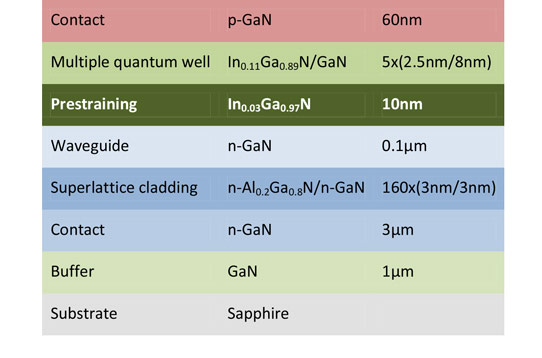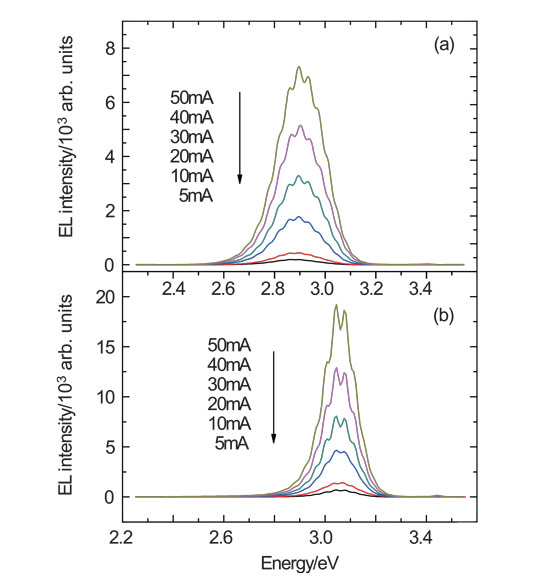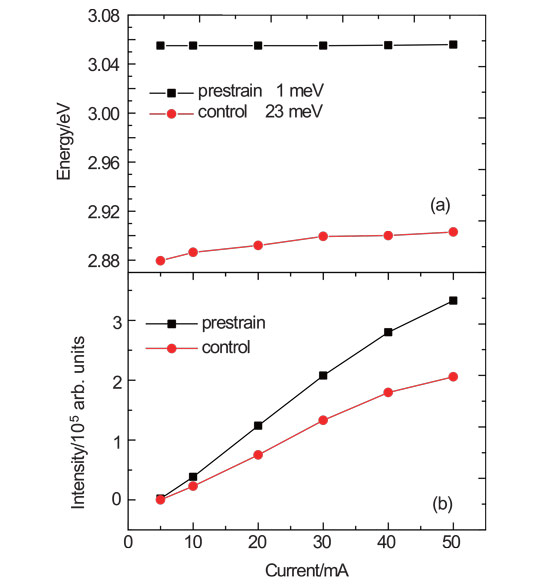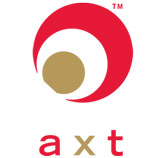- News
26 July 2013
Pre-straining for reduced quantum-confined Stark effect in blue laser diode material
Peking University has found that using a pre-strain layer in nitride semiconductor epitaxial structures designed for blue laser diodes (LDs) can reduce the efficiency-sapping quantum-confined Stark effect (QCSE) [Cao Wen-Yu et al, Chin. Phys. B, vol. 22, p076803, 2013].
The QCSE arises from the strongly polar nature of the III-nitride bond that leads to piezoelectric (strain-dependent) and spontaneous polarization fields. In multiple quantum well (MQW) structures used for generating light, the contrasts in polarization of the different layers lead to strong electric fields that tilt the potential wells and tend to pull apart the electrons and holes that should be combining into photons.
The LD epitaxial structures (Figure 1) were grown on c-plane sapphire using metal-organic chemical vapor deposition (MOCVD). The material was subjected to a series of measurements.

Figure 1: Epitaxial structure of material designed for blue LDs with pre-strain layer of InGaN. Control devices without this layer were also produced for comparison.
Electroluminescence spectral peak measurements showed that LDs with a pre-strain layer were blue-shifted to 3.05eV at 20mA, in comparison to control devices without such a layer that had a 2.89eV peak. This was attributed to the reduced QCSE from the tensile strain introduced into the GaN barriers from the pre-strain layer.
The spectrum measurement also showed a narrower linewidth for the pre-strained LDs due, it is thought, to reduced InGaN composition/potential fluctuations.

Figure 2: Electroluminescence spectra of (a) control sample and (b) pre-strained sample at various injection current levels.
In the current range 5-50mA, the control material’s peak photon energy 23meV varied from 2.879eV to 2.902eV, respectively. The blue-shift of the pre-strained sample was much less at 1meV, varying from 3.055eV to 3.056eV for the same injection current range.
Again, blue-shifts with increasing current injection are often attributed to QCSE, and the smaller blue-shift in the pre-strained LD suggests a weaker QCSE.

Figure 3: (a) Electroluminescence spectral peak shift and (b) integrated electroluminescence intensity as function of injection current in control and pre-strained samples.
The light intensity is also increased in the pre-strained devices: a 65% increase in the case of 20mA injection. Temperature-dependent photoluminescence measurements suggest internal quantum efficiencies (IQEs) of ~14% for the control material and ~24% for the pre-strained sample.
The researchers used simulations to help understand the effect of the pre-strain layer. It was found that one effect was to reduce the piezoelectric field in the wells from the range 780-874kV/cm in the control structure to 579-619kV/cm with the pre-straining. Also, the overlap of the electron and hole wavefunctions was increased from 43-50% to 60-64%, respectively.
Increased wavefunction overlap should result in increased radiation output. QCSE tends to pull the electrons and holes apart, reducing overlap.
http://iopscience.iop.org/1674-1056/22/7/076803
The author Mike Cooke is a freelance technology journalist who has worked in the semiconductor and advanced technology sectors since 1997.







